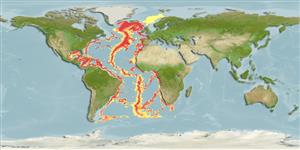Classification / Names
Common names | Synonyms | Catalog of Fishes(genus, species) | ITIS | CoL | WoRMS | Cloffa
Teleostei (teleosts) >
Ophidiiformes (Cusk eels) >
Ophidiidae (Cusk-eels) > Neobythitinae
Etymology: Penopus: Greek, penia, -as, penomai = poverty + Greek, pous = feet.
More on author: Vaillant.
Environment: milieu / climate zone / depth range / distribution range
Ecology
Marine; bathydemersal; depth range 960 - 3535 m (Ref. 34024). Deep-water
Western Atlantic: from 38°29'030''N, 70°57'W (holotype of P. macdonaldi) southwards through the Gulf of Mexico to 22°45.7'S, 40°19.6'W. East Atlantic: from 34°28'N, 7°43'W southwards through the Gulf of Guinea to 36°06'S, 19°33'E.
Size / Weight / Age
Maturity: Lm ? range ? - ? cm
Max length : 35.0 cm TL male/unsexed; (Ref. 4103)
Dorsal spines (total): 0; Dorsal soft rays (total): 135 - 158; Anal spines: 0; Anal soft rays: 106 - 122; Vertebrae: 77 - 83. Penopus microphthalmus differs from P. japonicus by the following characters: has a higher number of dorsal, 135-158 (vs. 117) and anal, 106-122 (vs. 89) fin rays; lower number of preopercular spines, 4-7 (vs. 9); indistinct spine behind the posterior nostril (vs. distinct, 1% SL); by the bigger horizontal diameter of the eye 1.1-1.6% SL (vs. 0.8); and in having an almost fully scaled head (vs. squamation of the head restricted to the middle part of the preopercle) (Ref. 87601).
Rare species (Ref. 34024). Oviparous, with oval pelagic eggs floating in a gelatinous mass (Ref. 205).
Life cycle and mating behavior
Maturity | Reproduction | Spawning | Eggs | Fecundity | Larvae
Nielsen, J.G. and S. Ohashi, 2011. A new species of Penopus (Teleostei: Ophidiidae) from the Ryukyu Trench, the West Pacific, with remarks on Penopus microphthalmus. Ichthyol. Res. 58(3):232-237. (Ref. 87601)
IUCN Red List Status (Ref. 130435: Version 2024-2)
Threat to humans
Harmless
Human uses
Fisheries: of no interest
Tools
Special reports
Download XML
Internet sources
Estimates based on models
Preferred temperature (Ref.
123201): 2.2 - 5.1, mean 3.9 °C (based on 844 cells).
Phylogenetic diversity index (Ref.
82804): PD
50 = 0.7500 [Uniqueness, from 0.5 = low to 2.0 = high].
Bayesian length-weight: a=0.00110 (0.00040 - 0.00297), b=3.08 (2.85 - 3.31), in cm total length, based on LWR estimates for this (Sub)family-body shape (Ref.
93245).
Trophic level (Ref.
69278): 3.6 ±0.6 se; based on size and trophs of closest relatives
Resilience (Ref.
120179): Medium, minimum population doubling time 1.4 - 4.4 years (Preliminary K or Fecundity.).
Fishing Vulnerability (Ref.
59153): Low vulnerability (25 of 100).
